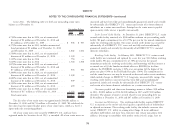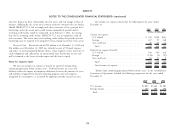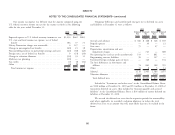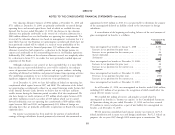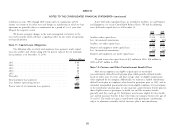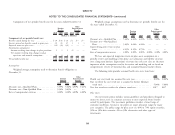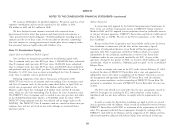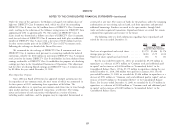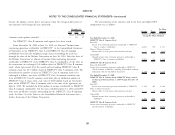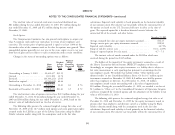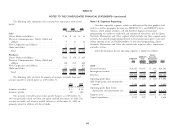DIRECTV 2010 Annual Report Download - page 106
Download and view the complete annual report
Please find page 106 of the 2010 DIRECTV annual report below. You can navigate through the pages in the report by either clicking on the pages listed below, or by using the keyword search tool below to find specific information within the annual report.
DIRECTV
NOTES TO THE CONSOLIDATED FINANCIAL STATEMENTS—(continued)
Components of net periodic benefit cost for the years ended December 31: Weighted-average assumptions used to determine net periodic benefit cost for
the years ended December 31:
Other
Pension Postretirement Other
Benefits Benefits Pension Postretirement
2010 2009 2008 2010 2009 2008 Benefits Benefits
(Dollars in Millions) 2010 2009 2008 2010 2009 2008
Components of net periodic benefit cost Discount rate—Qualified Plan . . . 5.64% 6.06% 6.22% 5.21% 5.88% 5.76%
Benefits earned during the year ............. $19 $16 $16 $1 $— $— Discount rate—Non-Qualified
Interest accrued on benefits earned in prior years . . 28 28 27 1 1 1 Plans .................. 5.63% 6.04% 6.24% — — —
Expected return on plan assets .............. (32) (30) (30) — — — Expected long-term return on plan
Amortization components assets .................. 8.25% 8.25% 8.75% — — —
Amount resulting from changes in plan provisions 1 1 1 (1) — — Rate of compensation increase . . . 4.00% 4.00% 4.00% 4.00% 4.00% 4.00%
Net amount resulting from changes in plan
experience and actuarial assumptions ....... 14 8 4 — — — We base our expected long-term return on plan assets assumption on a
Net periodic benefit cost ................. $30 $23 $18 $1 $ 1 $ 1 periodic review and modeling of the plans’ asset allocation and liability structure
over a long-term horizon. Expectations of returns for each asset class are the most
important of the assumptions used in the review and modeling and are based on
Assumptions comprehensive reviews of historical data and economic/financial market theory.
Weighted-average assumptions used to determine benefit obligations at The following table provides assumed health care costs trend rates:
December 31:
2010 2009
Other
Pension Postretirement Health care cost trend rate assumed for next year ............ 8.00% 8.00%
Benefits Benefits Rate to which the cost trend rate is assumed to decline (ultimate
2010 2009 2010 2009 trend rate) .................................... 5.00% 5.00%
Discount rate—Qualified Plans ............. 5.59% 5.64% 4.99% 5.21% Year that trend rate reaches the ultimate trend rate ........... 2017 2017
Discount rate—Non-Qualified Plans ......... 5.54% 5.63% — —
Rate of compensation increase ............. 4.00% 4.00% 4.00% 4.00% Plan Assets
Our investment policy includes various guidelines and procedures designed to
ensure we invest assets in a manner necessary to meet expected future benefits
earned by participants. The investment guidelines consider a broad range of
economic conditions. Central to the policy are target allocation ranges by major
asset categories. The policy range for plan assets are 40% to 70% equity securities,
30% to 50% debt securities, 0% to 30% alternatives and other types of
investments.
84






